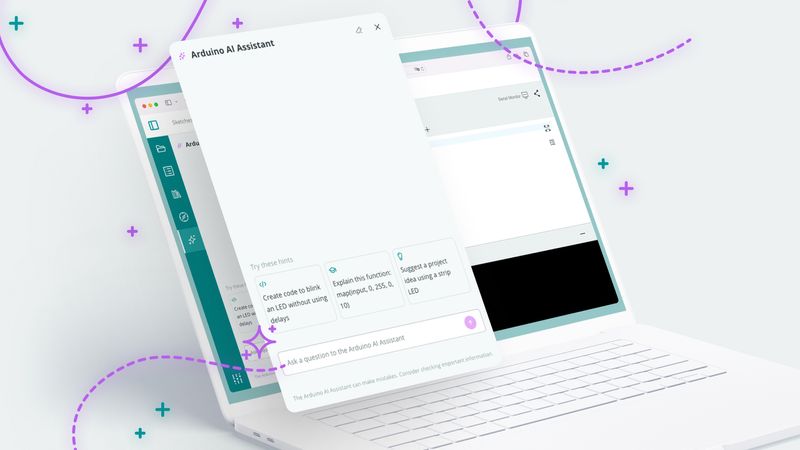Coding in the Age of AI: What Generative Tools Mean for Engineers
What’s particularly exciting is not just that Gen AI can write code – it’s that it’s beginning to understand context, reduce time spent on boilerplate, and support developers where they work best: in the flow of creation.

Whether you’re exploring hardware for the first time or optimizing an industrial deployment, tools like the Arduino AI Assistant help you move faster, learn more, and stay focused on the creative part of building.
While the current wave of Generative AI may feel sudden – even overwhelming – it’s been decades in the making. The earliest seeds were planted as far back as the 1950s, when computer scientists like Alan Turing posed fundamental questions about machine intelligence and programs capable of generating human-like responses. By the 1960s, researchers at MIT were experimenting with text generation using rule-based systems. And by the 1980s and 1990s, neural networks and early natural language models were beginning to show real promise, albeit limited by available computing power.
Fast forward to 2017, when the Transformer architecture was introduced in a landmark Google paper – paving the way for large language models (LLMs) like GPT-3 and, later, ChatGPT, Claude, and others. These models began to demonstrate the ability not just to generate text, but to understand and respond to complex instructions – a turning point that redefined what’s possible in automation and software development.
The game-changing moment for AI adoption came with OpenAI’s free launch of ChatGPT, in late 2022. It was the move that effectively democratized access to AI technology – much like Arduino did with microcontrollers 20 years ago, proving that accessibility is the only way to truly unleash innovation.
Industry site There’s An AI For That currently boasts a database of 27,728 AIs available for over 15,781 tasks. GitHub reports that its Copilot tool is now writing up to 46% of code in some supported languages. Meanwhile, the 2024 survey from Stack Overflow indicates that 76% of developers are already using or planning to use AI in their workflow this year.
For many, this shift feels both exciting and destabilizing. The tools are improving faster than developers can adjust to them. Yet for embedded engineers and technical makers, this moment also presents an incredible opportunity: to rethink what coding looks like, to reduce complexity, and to build smarter and faster – with a little help from an AI that understands code. So, let’s take a look at what Gen AI is today.
What’s Possible Now: 4 Engineering Wins with Gen AI
1. Context-aware code generation
Traditionally, writing embedded code involved stitching together fragments from scattered documentation or GitHub gists. Now, developers can describe what they want in plain language – think, “toggle a relay every 10 seconds using a timer interrupt” – and get working code, adapted to their hardware. This drastically lowers the entry point for newcomers, while saving hours of boilerplate for pros.
2. Custom training opportunity
To improve AI consistency and avoid so-called “hallucinations” (random or out-of-context responses), many online AI services like Google’s Notebook LM allow users to upload custom data to train the machine learning algorithm. This creates a personalized assistant with focused knowledge on specific topics. This is important, for example, because developers working with physical devices can add information about the hardware on which they are working.
3. Fast, in-place debugging
Debugging is where AI assistants really shine. Instead of sifting through obscure forum threads, you can now paste a block of non-working code and ask what’s wrong. In seconds, AI highlights syntax errors, misused libraries, or incorrect pin references – accelerating time-to-fix in a way that’s particularly helpful when you’re deep into a prototyping sprint.
4. Natural-language explanations
Complex embedded projects often involve unfamiliar APIs or abstract syntax. Gen AI tools can now explain code sections as if they were comments – giving you the “why” behind the logic. This is proving invaluable for education, onboarding, and even refactoring legacy code.
For a company like Arduino – founded to “make complex technology simple, giving everyone the tools to innovate” – this evolution is a natural extension of our original mission. We believe generative AI isn’t replacing engineers, but actually empowering them.
Introducing the Arduino AI Assistant: An Embedded-native Approach
We know many developers already rely on AI tools like ChatGPT or GitHub Copilot, but context-switching between platforms slows everything down. That’s why, combining context-aware, personalized trained databases with datasheet, code, and libraries, we built the Arduino AI Assistant, integrated directly into the Arduino Cloud Editor: powered by Anthropic’s Claude model, it’s designed specifically for embedded development with Arduino.
The Assistant lives right inside the online IDE, so it has the full context of your board, libraries, and project structure – something generic AI chatbots can’t offer.
Ready to try it out? You can find out more about it from the blog announcement or head straight to Arduino Cloud to explore on your own.